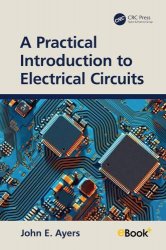 Название: A Practical Introduction to Electrical Circuits
Название: A Practical Introduction to Electrical CircuitsАвтор: John E. Ayers
Издательство: CRC Press
Год: 2024
Страниц: 441
Язык: английский
Формат: pdf (true)
Размер: 36.7 MB
The concept for this book developed over three decades, as I fine-tuned my delivery of the electrical circuits course at the University of Connecticut. Having talked with thousands of students taking the course, I learned what they really wanted and needed to master the subject. They wanted a text that was comprehensive yet compact, concise, and easy to use. They needed solved examples, with a wide cross-section of topics, which attacked the problems from start to finish, and which explained the process in a step-by-step fashion. They needed a source that was practical in its description of analysis techniques, components, design, and methods of measurement.
A Practical Introduction to Electrical Circuits represents a fresh approach to the subject which is compact and easy to use, yet offers a comprehensive description of the fundamentals, including Kirchhoff’s laws, nodal and mesh analysis, Thevenin and Norton’s theorems, and maximum power transfer for both DC and AC circuits, as well as transient analysis of first- and second-order circuits. Advanced topics such as mutual inductance and transformers, operational amplifier circuits, sequential switching, and three-phase systems reinforce the fundamentals. Approximately one hundred solved examples are included within the printed copy. Extra features online include over two hundred additional problems with detailed, step-by-step solutions, and 40 self-service quizzes with solutions and feedback.
Circuit theory is an important tool for the design and analysis of electrical systems, which include digital systems and computers; biomedical instruments such as electrocardiographs and blood glucose monitors; imaging systems such as radars, sonars, and ultrasound systems; sensor systems including air quality monitors, seismographs, and strain gauges on transportation systems; communication systems such as the internet, radio, television, and telephones; power systems including nuclear reactors, wind turbines, and photovoltaic panels; and vehicle systems including engine monitors and controls, anti-lock braking and traction control systems, and self-driving systems. Electrical circuit theory is therefore applicable to every subfield of engineering, including the electrical, computer, biomedical, civil, mechanical, automotive, aerospace, and environmental engineering fields.
Скачать A Practical Introduction to Electrical Circuits
[related-news] [/related-news]
Комментарии 0
Комментариев пока нет. Стань первым!















